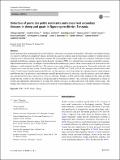| dc.description.abstract | Small ruminants play an important role in the livelihoods of resource-constrained communities. This study was initiated because of a massive outbreak of a respiratory disease in sheep and goats in Loliondo area in Ngorongoro district of Arusha region in Tanzania in 2016. During flock examination, a total of 240 serum samples and 61 nasal swabs were collected. Antibodies to small ruminant morbillivirus, causative agent of peste des petits ruminants (PPR), were detected from sera using a competitive enzyme-linked immunosorbent assay. A multiplex reverse transcription real-time polymerase chain reaction assay was used to detect four pathogens: small ruminant morbillivirus, Mycoplasma capricolum subspecies capripneumoniae, Pasteurella multocida, and Capripoxvirus from the nasal swabs. Overall seroprevalence of PPR was 74.6%, with all four pathogens detected from nasal swabs. Co-infections of small ruminant morbillivirus and Mycoplasma capricolum subspecies capripneumoniae, small ruminant morbillivirus and Capripoxvirus, small ruminant morbillivirus and Pasteurella multocida, and Mycoplasma capricolum subspecies capripneumoniae and Capripoxvirus were also detected. Presence of PPR and the other diseases in this study provided insight into the severity of the outbreak in sheep and goats in Ngorongoro district. Thus, laboratory confirmation is critical for prompt and appropriate interventions to be made for control of diseases in sheep and goats with similar clinical signs. The findings also call for research into development of combined vaccines targeting common diseases of small ruminants in Tanzania. | en_US |

